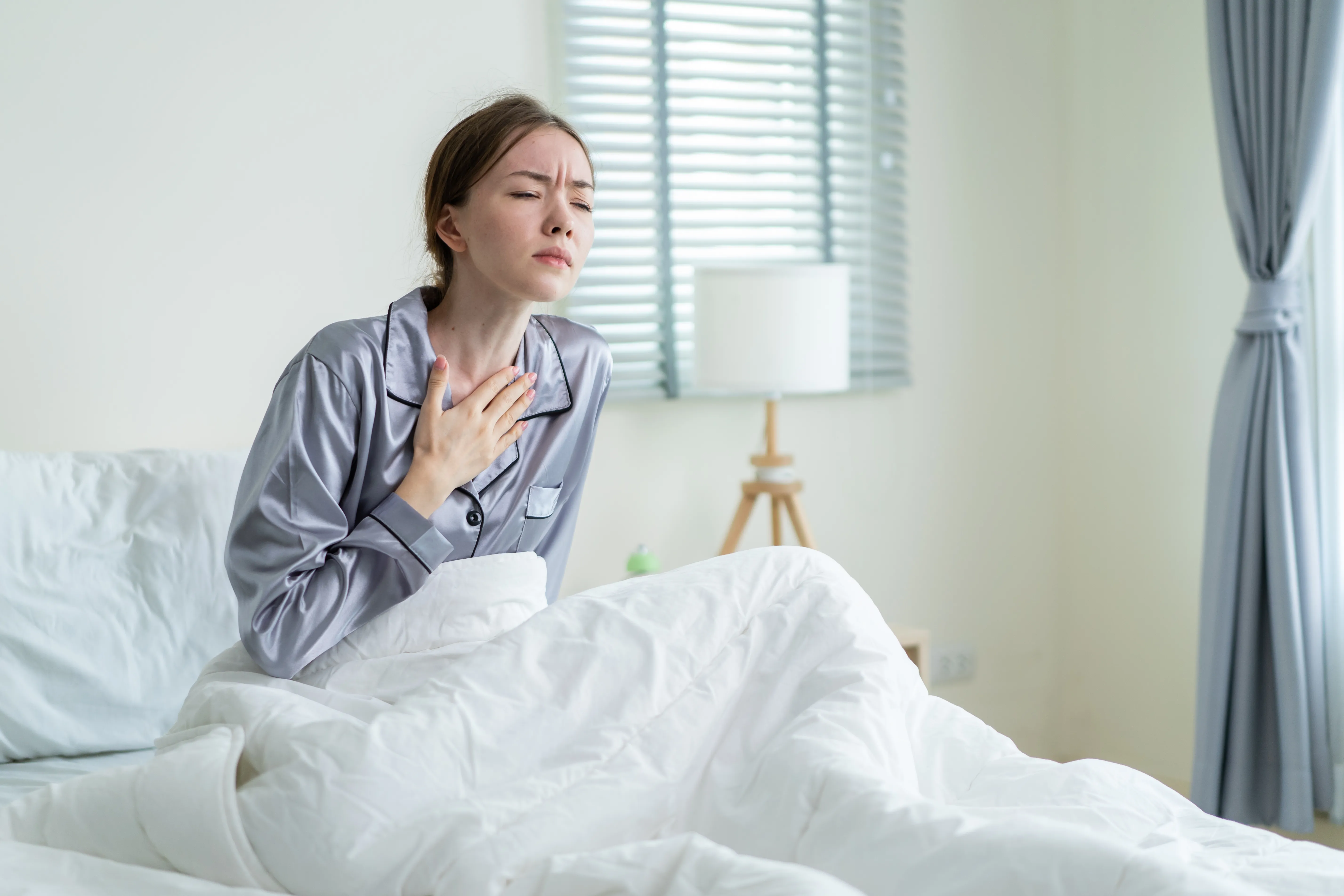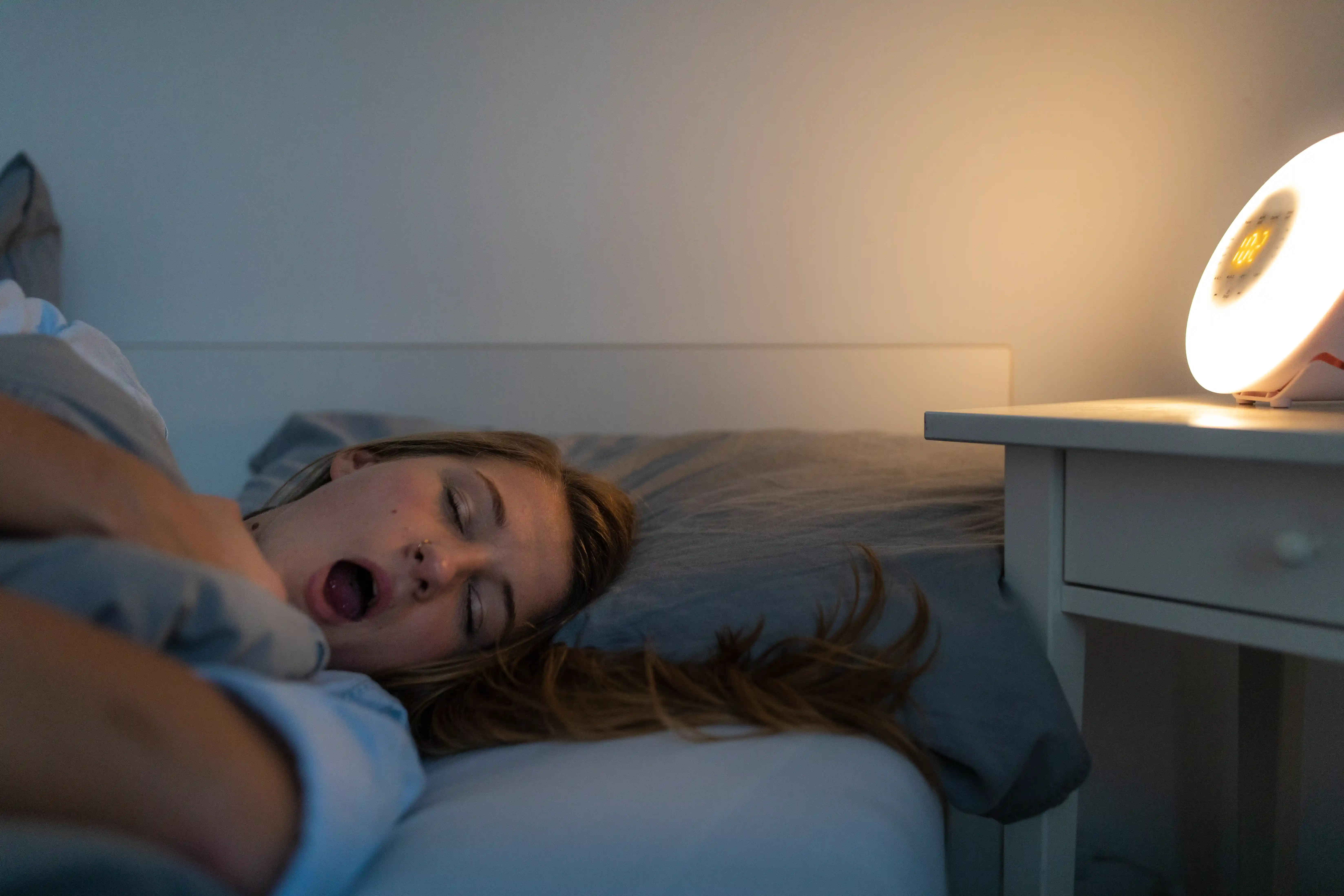Sleep is essential for overall well-being, yet for some people, nighttime brings unexpected challenges that disrupt rest and signal deeper health concerns.
One such condition is Paroxysmal Nocturnal Dyspnea (PND)—a form of sudden breathlessness that occurs during sleep. While it may appear to be a simple sleep disturbance, PND often points to more serious underlying medical issues and warrants close attention.
In this article, we explore what Paroxysmal Nocturnal Dyspnea (PND) is, how it differs from other sleep-related breathing disorders like sleep apnea, and the treatment options available to support accurate diagnosis and long-term management.
What is Paroxysmal Nocturnal Dyspnea?
Paroxysmal Nocturnal Dyspnea (PND) is a condition characterized by sudden episodes of severe shortness of breath that occur during sleep, often waking the person up in the middle of the night.
It is typically caused by fluid buildup in the lungs due to heart failure or other underlying cardiovascular or pulmonary conditions. Unlike ordinary breathlessness, PND episodes are intense and can feel like suffocation, prompting the individual to sit or stand up to relieve the discomfort.
These episodes usually occur a few hours after falling asleep and can be a warning sign of serious heart or lung issues that require medical attention.
Key Symptoms of Paroxysmal Nocturnal Dyspnea

Paroxysmal nocturnal dyspnea (PND) presents through a set of distinct symptoms that often emerge suddenly during the night. These episodes can be alarming and are typically linked to underlying heart or lung conditions. Recognizing these signs early can help guide timely diagnosis and treatment.
Sudden Awakening With Shortness Of Breath
Individuals with PND often wake up abruptly from sleep, feeling as though they can’t breathe. This sudden breathlessness can create a sense of panic and typically prompts the person to sit up immediately.
Feeling Of Suffocation During Sleep
Many people describe a sensation of being smothered or drowning. This is due to the accumulation of fluid in the lungs, which interferes with normal oxygen exchange.
Gasping For Air While Lying Down
Gasping or breathing becomes labored and shallow, especially when in a flat position. The discomfort may intensify if the person does not adjust to a more upright posture.
Coughing Or Wheezing At Night
Persistent coughing or wheezing during sleep can accompany shortness of breath. These respiratory sounds are caused by fluid buildup irritating the airways and restricting airflow.
Chest Tightness Or Discomfort
PND can cause a sensation of pressure or constriction in the chest. This discomfort can sometimes be mistaken for cardiac-related pain, adding to the distress.
Anxiety Or Panic Upon Waking
The experience of breathlessness often triggers intense fear or anxiety. These emotional responses can exacerbate the physical symptoms, making recovery more difficult.
Relief When Sitting Or Standing Upright
Symptoms tend to ease when the individual moves into an upright position. This shift helps gravity pull fluid away from the lungs, improving breathing almost immediately.
Sweating Or Rapid Heartbeat During Episodes
Sweating and rapid heartbeat are common stress responses triggered by the body’s effort to restore oxygen flow. Such physical signs often linger for several minutes even after breathing normalizes.
Common Causes of Paroxysmal Nocturnal Dyspnea

Paroxysmal Nocturnal Dyspnea (PND) is not a disease on its own but rather a symptom of underlying medical conditions, many of which are serious and require medical attention. It often arises when the body’s ability to manage fluid or blood flow becomes compromised, particularly during sleep.
Below is a breakdown of the most common causes grouped by category to provide a clearer picture of how PND develops.
Heart-Related Causes
- Congestive Heart Failure: The heart cannot pump blood effectively, leading to fluid backup in the lungs and difficulty breathing at night.
- Left Ventricular Dysfunction: When the left ventricle is weakened, it fails to circulate blood properly, causing fluid accumulation in the lungs during sleep.
- Mitral Valve Disease: A malfunction of the mitral valve can result in blood flowing backward into the lungs, triggering nighttime breathlessness.
- Hypertension: High blood pressure increases the workload on the heart and can lead to structural heart changes and pulmonary congestion.
- Coronary Artery Disease: Narrowed arteries reduce blood supply to the heart, weakening its function and potentially causing fluid buildup in the lungs.
Lung-Related Causes
- Pulmonary Edema: Excess fluid in the lungs, often due to heart problems, makes it hard to breathe, especially when lying down.
- Obstructive Sleep Apnea: This condition causes intermittent pauses in breathing during sleep, which can mimic or worsen nocturnal dyspnea.
Other Contributing Causes
- Chronic Kidney Disease: Poor kidney function leads to fluid retention, which may accumulate in the lungs and interfere with nighttime breathing.
- Fluid Overload: Excess fluid from conditions like kidney failure or overhydration can leak into the lungs, worsening symptoms at night.
- Severe Anemia: A lack of red blood cells reduces oxygen delivery to tissues, causing shortness of breath that can intensify during sleep.
PND vs. Other Sleep-Related Breathing Disorders
Understanding Paroxysmal Nocturnal Dyspnea (PND) in the broader context of sleep-related breathing disorders is crucial for accurate diagnosis and effective treatment.
While conditions like obstructive sleep apnea or central sleep apnea may share overlapping symptoms with PND—such as nighttime shortness of breath or disrupted sleep—their causes, mechanisms, and treatments differ significantly.
| Feature | Paroxysmal Nocturnal Dyspnea (PND) | Obstructive Sleep Apnea (OSA) | Central Sleep Apnea (CSA) |
|---|---|---|---|
| Cause | Fluid buildup in lungs due to heart failure | Airway blockage due to relaxed throat muscles | Brain fails to send proper signals to breathe |
| Onset | Sudden, usually hours after falling asleep | Gradual, occurs throughout the night | Gradual, cyclical pattern throughout the night |
| Primary Symptom | Sudden breathlessness requiring upright position | Loud snoring, gasping, choking | Pauses in breathing without snoring |
| Associated Condition | Congestive heart failure | Obesity, anatomical blockages | Heart failure, neurological disorders |
| Treatment Focus | Manage heart function and fluid levels | Open airway and improve breathing during sleep | Stabilize breathing rhythm |
| Diagnostic Tools | Cardiac evaluation, chest X-ray, echocardiogram | Polysomnography (sleep study) | Polysomnography with advanced respiratory metrics |
How PND Affects Sleep and Health
PND can severely disrupt sleep by causing individuals to wake up gasping for air. The sudden need to sit or stand to catch one’s breath fragments sleep architecture and reduces restfulness. Over time, this pattern can lead to chronic sleep deprivation, fatigue, and poor quality of life.
Beyond sleep, PND may signal worsening heart failure or fluid overload, both of which pose serious cardiovascular risks. Recurrent nighttime episodes can also increase anxiety around sleep, contributing to further sleep disturbances and psychological stress.
Diagnosis and Medical Evaluation
Diagnosing PND involves a thorough assessment of both the cardiac and respiratory systems. Physicians typically begin with a detailed patient history, focusing on sleep patterns, heart symptoms, and fluid retention. Tests may include chest X-rays, echocardiograms, ECGs, and blood work to assess heart function and fluid balance.
In some cases, a sleep study may be ordered to rule out coexisting sleep apnea. Accurate diagnosis is essential, as treating the underlying cause—often heart failure—is the most effective way to resolve PND symptoms.
Treatment Options
Treating Paroxysmal Nocturnal Dyspnea (PND) requires a multifaceted approach that targets both the immediate symptoms and the underlying medical conditions contributing to nighttime breathing difficulties.
Since PND is often a sign of serious heart or lung conditions—particularly congestive heart failure—management must be prompt, holistic, and sustained over time. Below are the most effective treatment categories.
Medications
Medications are often the first line of treatment for managing PND, especially when it is related to heart failure or fluid overload.
- Diuretics (e.g., furosemide, bumetanide): These medications help the body eliminate excess fluid through increased urination. By reducing pulmonary congestion, they ease shortness of breath at night and relieve pressure on the heart and lungs.
- ACE Inhibitors or ARBs: Angiotensin-converting enzyme (ACE) inhibitors and angiotensin receptor blockers (ARBs) help relax blood vessels, improve blood flow, and reduce the workload on the heart. They also slow the progression of heart failure and improve survival.
- Beta-blockers: These medications help control heart rate and reduce the heart’s oxygen demand. They are commonly used in chronic heart failure to improve heart function and prevent arrhythmias that can worsen nighttime symptoms.
- Aldosterone Antagonists (e.g., spironolactone): These drugs are useful in managing fluid retention and have been shown to improve outcomes in patients with heart failure with reduced ejection fraction (HFrEF).
- Vasodilators: In some cases, medications that dilate blood vessels may be prescribed to reduce blood pressure and help ease cardiac stress.
Device-Based and Surgical Interventions
For individuals with advanced or poorly controlled underlying conditions, more intensive interventions may be necessary.
- CPAP or BiPAP Therapy: If the patient also has obstructive or central sleep apnea, positive airway pressure devices like CPAP or BiPAP can maintain open airways during sleep and reduce breathing interruptions that contribute to PND episodes.
- Implantable Cardiac Devices: In patients with arrhythmias or heart failure with a reduced ejection fraction, devices such as pacemakers or implantable cardioverter defibrillators (ICDs) can help regulate heart function and improve overall stability.
- Valve Repair or Replacement Surgery: If mitral valve disease is a contributing factor, surgical correction may be necessary to restore normal blood flow and prevent backward pressure into the lungs.
Management of Comorbid Conditions
Many patients with PND have overlapping medical issues that must be addressed in tandem.
- Control of Hypertension and Diabetes: Poorly controlled blood pressure, diabetes, and blood sugar can exacerbate heart failure and vascular problems. Aggressive management of these conditions is essential to reduce the risk of recurring PND.
- Treatment of Anemia: Low hemoglobin levels can impair oxygen delivery and increase breathlessness. Identifying and correcting iron deficiency or other causes of anemia can ease nighttime symptoms.
Lifestyle Changes to Alleviate Symptoms

Paroxysmal Nocturnal Dyspnea (PND) can be deeply unsettling, especially when it interrupts sleep and leaves you gasping for breath at night. While medical treatment is essential for addressing the root causes, certain lifestyle changes can play a powerful supporting role in reducing symptoms and improving overall quality of life.
Maintain A Healthy Weight
Excess weight puts strain on the heart and lungs, worsening symptoms like shortness of breath. Losing even a small amount of weight can improve cardiovascular efficiency and ease nighttime breathing issues.
Follow a Low-Sodium Diet
Too much sodium in your diet causes the body to retain water, leading to fluid buildup and increased pressure on the heart. Reducing salt can help decrease swelling and improve breathing comfort, especially at night.
Limit Fluid Intake Before Bed
Drinking too much in the evening may worsen fluid retention, contributing to nocturnal breathlessness. Try to consume most of your fluids earlier in the day and limit intake 1–2 hours before bedtime.
Elevate the Head While Sleeping
Keeping your upper body slightly elevated helps prevent fluid from pooling in the lungs. Use wedge pillows or an adjustable bed to make breathing easier and reduce nighttime symptoms.
Avoid Alcohol and Caffeine in the Evening
Alcohol and caffeine can disrupt sleep and affect heart rhythm and breathing patterns. Avoiding them late in the day supports better rest and may reduce the frequency of nighttime breathing episodes.
Engage in Regular Physical Activity
Gentle aerobic exercises like walking or swimming strengthen the heart and lungs. A consistent routine improves circulation, enhances stamina, and can significantly reduce the symptoms of PND.
Manage Stress Through Relaxation Techniques
Stress and anxiety can trigger or worsen nighttime symptoms. Techniques like meditation, deep breathing, and guided imagery help calm the nervous system and promote more restful sleep.
Quit Smoking
Smoking damages the lungs and blood vessels, worsening shortness of breath and increasing fluid retention. Quitting smoking improves oxygen exchange, reduces inflammation, and significantly benefits heart and lung health.
Monitor Blood Pressure and Blood Sugar
Keeping hypertension and diabetes under control can reduce the burden on the cardiovascular system. Regular monitoring and medication adherence are key to preventing complications that contribute to PND.
Take Medications as Prescribed
Skipping doses or misusing medications can cause fluid retention or blood pressure spikes. Following your doctor’s treatment plan ensures optimal symptom control and reduces the likelihood of nighttime distress.
FAQs
What should I do if I experience a PND episode at night?
It's advisable to sit up or stand, as this position helps alleviate pressure on the lungs and improves breathing. If episodes persist, seeking medical attention is crucial.
Can stress trigger PND episodes?
While stress itself may not directly cause PND, it can exacerbate symptoms by increasing heart rate and blood pressure. Managing stress through relaxation techniques or therapy can be beneficial.
Is PND a sign of a serious health condition?
PND is often linked to underlying conditions such as heart failure or respiratory disorders. It's important to consult with a healthcare provider for a thorough evaluation.
Are there any home remedies for managing PND?
In addition to lifestyle changes, some individuals find relief through breathing exercises or using a humidifier to maintain optimal air quality.
Can PND affect daytime activities?
Yes, frequent episodes can lead to daytime fatigue and decreased productivity. Managing symptoms effectively can improve overall daily functioning.
How is PND different from sleep apnea?
While both conditions involve breathing difficulties during sleep, PND is typically linked to cardiac or pulmonary issues, whereas sleep apnea is characterized by repeated pauses in breathing.
Can medication completely cure PND?
Medications can help manage symptoms and improve quality of life, but addressing the underlying cause is essential for long-term relief.
Is it safe to travel with PND?
Travel is generally safe, but it's important to discuss plans with a healthcare provider to ensure appropriate management during the trip.
Conclusion
Paroxysmal Nocturnal Dyspnea is more than just a nighttime inconvenience—it’s often a symptom of something greater. Recognizing its signs and seeking proper medical evaluation can lead to effective treatment and improved quality of life. With the right support, those affected can breathe easier, both at night and during the day.
Jessica H.
Jessica is a reviewer, writer, and sleep enthusiast at Sleepiverse. Jessica graduated with her master's degree in Nursing research and education. She is a registered nurse and currently works in the Intensive Care Unit. Since becoming a nurse, Jessica has worked the night shift, which means a disrupted sleep schedule. Knowing she needed to function at her best while caring for patients at night, she spent a lot of time researching how to sleep well with a difficult schedule.


